Wai-Fah Chen.The Civil Engineering Handbook
Подождите немного. Документ загружается.

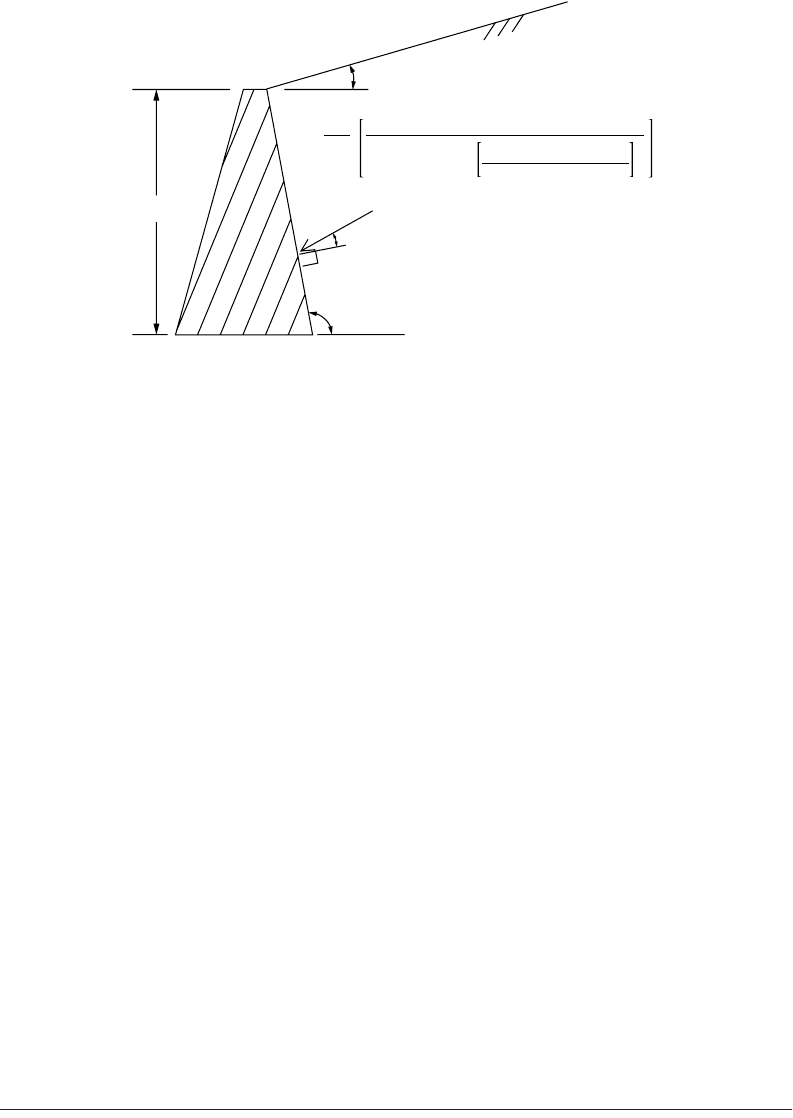
22-4 The Civil Engineering Handbook, Second Edition
Coulomb Theory
Coulomb [1776] solved the lateral earth pressure problem assuming a homogeneous, isotropic material,
rough wall, planar failure surface, and Mohr–Coulomb strength criterion. A wide range of earth pressure
problems can be solved using the force polygon technique implied in Coulomb’s method. The closed-
form solution for the minimum active earth force for a general case including dry, cohesionless material,
inclined rough wall, and sloping backfill is presented in Fig. 22.3. Coulomb theory can overestimate the
actual maximum passive earth pressure acting on a rough wall with the wall friction angle,
d, greater
than half of f, so its use should be avoided. The use of log-spiral failure surfaces, as opposed to planar
failure surfaces, provides good estimates of minimum active and maximum passive earth pressures, and
graphical solution charts are available (see Fig. 22.4).
Example 22.1 — Lateral Earth Pressure
Calculate the resultant active earth pressure by Rankine theory for the case shown in Fig. 22.5(a).
Solution.
Sand (f¢ = 30˚, c ¢ = 0): K
a
= tan
2
(45˚ - f¢/2) = tan
2
(45˚ - 30˚/2) = 0.333; p¢
a
=K
a
g¢z = K
a
r¢gz
Clay (f = 0˚, c = 24 kPa): K
a
= tan
2
(45 - 0˚/2) = 1.0; p
a
= r
t
gz - 2c
At z = 3 m, p¢
a
= K
a
r¢gz = (0.333) (2.0 Mg/m
3
) (9.81 m/s
2
) (3 m) = 19.6 kPa
At z = 6
–
m, p¢
a
= 19.6 kPa + (0.333) (2.0 - 1.0 Mg/m
3
) (9.81 m/s
2
)(3 m) = 29.4 kPa
At z = 6
–
m, u = r
w
gz
w
= (1 Mg/m
3
) (9.81 m/s
2
) (3 m) = 29.4 kPa
At z = 6
+
m, p
a
= r
t
gz - 2c = (2 Mg/m
3
) (9.81 m/s
2
) (6 m) – 2(24 kPa) = 69.7 kPa
At z = 12
–
m, p
a
= 69.7 kPa + (1.8 Mg/m
3
) (9.81 m/s
2
) (6 m) = 175.6 kPa
P
ae
= (19.6 kN/m
2
) (3 m) + (19.6 + 29.4 kN/m
2
) (3 m) + (69.7 + 175.6 kN/m
2
) (6 m)
= 839 kN/m
P
w
= (29.4 kN/m
2
) (3 m) = 44 kN/m
See Fig. 22.5(b) for pressure diagram.
22.4 Rigid Retaining Walls
Design lateral active earth pressures for low retaining walls (i.e., height <6 m) are often estimated using
conservative design charts [see Department of the Navy, 1982] or using equivalent fluid pressures. The
equivalent fluid unit weight, g
eq
, equals the product of the minimum active earth pressure coefficient
and the backfill material’s unit weight (i.e., g
eq
= K
a
· g), and
FIGURE 22.3 Closed-form solution for Coulomb minimum active earth force.
E
c
=
γH
2
2
H
β
φ
δ
γ
cscβsin (β − φ)
[sin (β − δ)]
1
/2
+
sin (δ + φ) sin (φ − α)
1
/2
sin (β − α)
2
α
E
c
1
2
--
1
2
--
1
2
--
1
2
--
© 2003 by CRC Press LLC
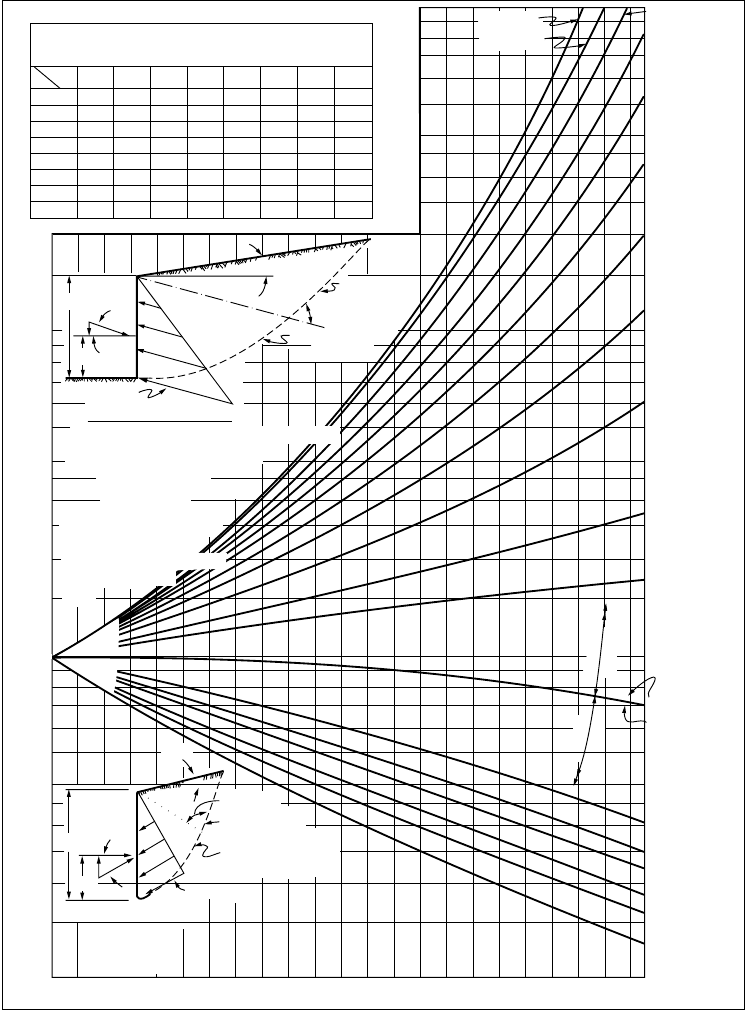
Retaining Structures 22-5
(22.6)
Conservative estimates of g
eq
for a variety of backfill materials are listed in Table 22.1. All earth retention
structures should be designed to sustain potential surcharge loadings, and typically a minimum surcharge
FIGURE 22.4 Minimum active and maximum passive lateral earth pressure coefficients developed from log-spiral
solution techniques. (After Department of the Navy. 1982. Foundations and Earth Structures: Design Manual 7.2.
NAVFAC DM-7.2, May.)
.978
.961
.939
.912
.878
.836
.783
.718
.962
.934
.901
.860
.811
.752
.682
.600
.946
.907
.862
.808
.746
.674
.592
.500
.929
.881
.824
.759
.686
.603
.512
.414
.912
.854
.787
.711
.627
.536
.439
.339
.898
.830
.752
.666
.574
.475
.375
.276
.881
.803
.716
.620
.520
.417
.316
.221
.864
−0.7
−0.6
−0.5
−0.4 −0.3
−0.2
−0.1 0.0
.775
.678
.574
.467
.362
.262
.174
REDUCTION FACTOR (R) OF K
P
FOR VARIOUS RATIOS OF − δ/f
b/f = −1
b/f = −.9
b/f = −.8
b/f = −.6
b/f = −.4
b/f = −.2
b/f = 0
b/f = +.2
b/f = +.4
b/f = +.6
b/f = +1
b/f = +.8
d = f, b/f = −.1
d = f, b/f = −.4
d = f, b/f = 0
d = f, b/f = +.4
d = f, b/f = +.6
d = f, b/f = +.8
d = f, b/f = +1
10
15
20
25
30
35
40
45
20.0
10.0
8.0
7.0
5.0
4.0
3.0
2.0
.9
1.0
.8
.7
.6
.5
.4
.3
.2
.1
01020304045
90.0
80.0
70.0
60.0
50.0
40.0
30.0
f
δ/f
+b
H
−δ
H/3
P
V
P
P
P
N
FAILURE
SURFACE
FAILURE
SURFACE
LOGARITHMIC
SPIRAL
LOGARITHMIC
SPIRAL
PASSIVE PRESSURE
P
A
= K
A
γH
2
/2
P
N
= P
A
COSδ
P
V
= P
A
SINδ
ACTIVE PRESSURE
H
P
V
P
N
P
A
σ
A
= K
A
γH
H/3
+δ
90°−f
90°−f
+b
σ
P
= K
P
γ
H
K
P
= R(K
P
FOR δ/f = −1)
R = .711
NOTE:CURVES SHOWN ARE
FOR δ/f = −1
EXAMPLE:f = 25°; b/f = −.2
d/f = −.3
ANGLE OF INTERNAL FRICTION, f, DEGREES
PASSIVE
ZONE
ACTIVE
ZONE
(K
P
FOR δ/f = −1) = 362
K
P
= .711x3.62=
2.58
P
P
= K
P
γH
2
/2; P
N
= P
P
COS δ; P
V
= P
P
SIN δ
COEFFICIENT OF PASSIVE PRESSURE, K
P
COEFFICIENT OF ACTIVE PRESSURE, K
A
p
a
g
eq
z◊=
© 2003 by CRC Press LLC
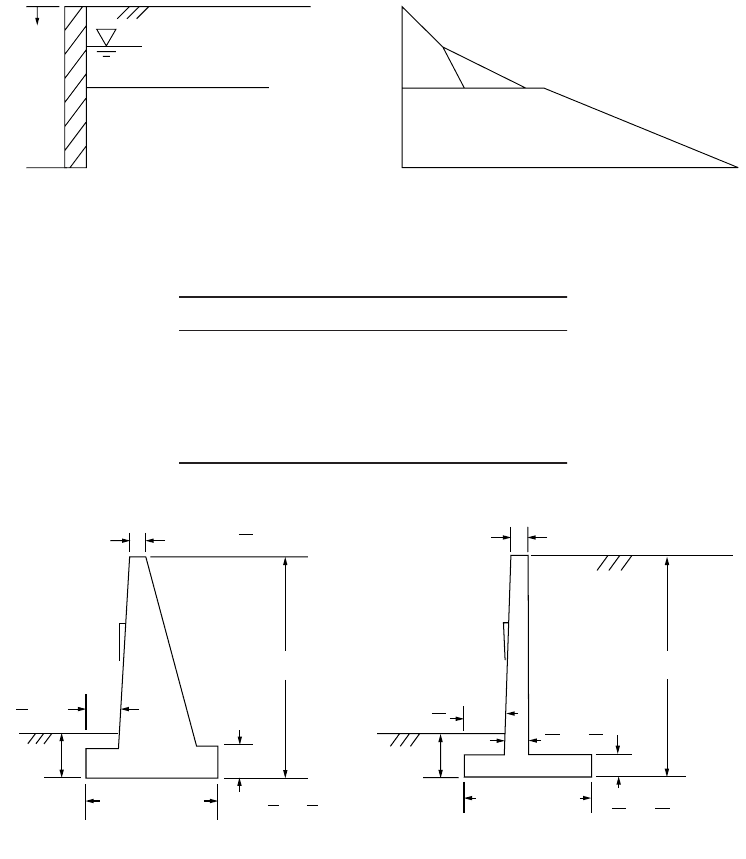
22-6 The Civil Engineering Handbook, Second Edition
load equivalent to an additional 0.6-m thickness of backfill is specified. Retaining walls should be
constructed with free-draining backfill materials and with effective drainage systems, because if water
can pond behind the wall the additional water pressure will dramatically increase the load on the wall.
If ponding cannot be precluded, the wall should be designed to resist the higher total pressures.
The general design procedure for gravity and cantilever retaining walls follows:
1. Characterize project site and subsurface conditions. Pay particular attention to groundwater and
surface water, site geology, availability of free-draining backfill soils, and potentially weak seams.
2. Select tentative wall dimensions (see Fig. 22.6).
3. Estimate the forces acting on the retaining wall (i.e., active earth pressure, weight, surcharge, and
resultant).
4. Check overturning stability; the resultant force should act within the middle third of the base of
the wall.
FIGURE 22.5 Example 22.1.
TABLE 22.1 Equivalent Fluid Unit Weights (kN/m3)
for Design of Low Retaining Walls
Level Backfill 2H:IV Backfill
Soil At-Rest Active Active
Clean sand or gravel 7.5 5 6
Silty sand 8.5 6 8
Clayey sand 9.5 7 9
Sandy clay 11 10 11
Fat clay 13 12 14
FIGURE 22.6 Te ntative gravity and cantilever wall dimensions.
z
3m
6m
(a) (b)
12m
SAND
c′ = 0, f′ = 30°
ρ
t
= 2.0 Mg/m
3
CLAY
c = 24kPa, f = 0°
ρ
t
= 1.8 Mg/m
3
0
P
w
19.6 kPa
58.8 kPa
69.7 kPa
29.4 kPa
175.6 kPa
Gravity Retaining Wall
Cantilever Retaining Wall
> 1 m
> 1 m
0.4 H to 0.7 H
B
1
48
B
3
H
12
H
10
to
H
12
H
8
to
H
0.25 m to 0.4 m
0.5 H to 0.7 H
H
8
H
6
D = to
D
2
Dto
48
1
H
0.3 m to
H
12
© 2003 by CRC Press LLC
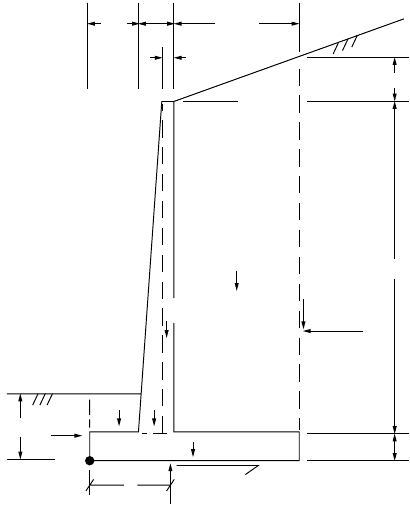
Retaining Structures 22-7
5. Check bearing capacity; maximum earth pressure on the wall base should be less than the allowable
earth pressure regarding bearing capacity or permissible settlement.
6. Check sliding; horizontal frictional resisting force on the base of the wall should be at least 1.5
times the horizontal driving force.
7. Check for excessive settlement from deeper soil deposits.
8. Check the overall stability of the earth mass that contains the retaining structure.
9. Apply load factors and compute reactions, shears, and moments in the wall.
10. Compute the ultimate strength of the structural components.
11. Check adequacy of structural components against applied factored forces and moments.
Design procedures differ for retaining systems built of reinforced soil [see Mitchell and Villet, 1987].
Example 22.2 — Cantilever Retaining Wall
Check the adequacy of the cantilever retaining wall shown in Fig. 22.7 regarding overturning, bearing
capacity, and sliding. The allowable bearing pressure is 360 kPa.
Solution. (a) The overall dimensions of the wall appear to be appropriate (see Fig. 22.6).
(b) Estimate the forces acting on wall:
W
1
= r
c
gA = (2.4 Mg/m
3
)(9.81 m/s
2
)(0.25 m · 8 m) = 47.1 kN/m
W
2
= (2.4 Mg/m
3
)(9.81 m/s
2
)(0.5 · 0.45 m · 8 m) = 42.4 kN/m
W
3
= (2.4 Mg/m
3
)(9.81 m/s
2
)(0.6 m · 4.5 m) = 63.6 kN/m
W
4
= r
t
gA ª (1.9 Mg/m
3
)(9.81 m/s
2
)(8.5 m · 2.8 m) = 444 kN/m
W
5
= (1.9 Mg/m
3
) (9.81 m/s
2
) (0.9 m · 1.0 m) = 16.8 kN/m
W
T
= ÂW
i
= 614 kN/m
Add 0.6 m of soil behind the wall to account for surcharge; hence, H = 0.6 m + 8 m + 1 m + 0.6 m =
10.2 m. Conservatively assume P
p
ª 0. Use the log-spiral solution for the sloping backfill to estimate K
a
(see Fig. 22.4).
FIGURE 22.7 Example 22.2.
1m
2.8m
0.7m
1m
8m
W
0.6m
0.25 m
b = 24°
P
av
W
3
W
5
A
W
2
W
1
P
ah
T
1.5m
x
SAND
c′ = 0
f′ = 35°
ρ
t
= 1.9 Mg/m
3
© 2003 by CRC Press LLC

22-8 The Civil Engineering Handbook, Second Edition
b/f = 24°/35° @ 0.7 and f¢ = 35° with d = f¢ Æ K
a
= 0.38
P
a
= K
a
g H
2
/2 = (0.38)(1.9 Mg/m
3
)(9.81 m/s
2
)(10.2 m)
2
/2 = 368 kN/m
P
ah
= P
a
cos d = (368 kN/m) cos 35° = 301 kN/m
P
av
= P
a
sin d = (368 kN/m) sin 35° = 211 kN/m
N = W
T
+ P
av
= 614 kN/m + 211 kN/m = 825 kN/m
T = N tan d
b
= (825 kN/m) tan 35° = 578 kN/m
Location of resultant, N:
(c) Check overturning:
(d) Check bearing capacity:
(e) Check sliding:
22.5 Flexible Retaining Structures
Flexible retaining structures include systems used in braced excavations, tie-back cuts, and anchored
bulkheads. In this section, braced excavation systems will be discussed. Braced excavation support systems
include walls, which may be steel sheetpiles, soldier piles with wood lagging, slurry placed tremie concrete,
or secant/tangent piles; and supports, which may be cross-lot struts, rakers, diagonal bracing, tiebacks,
or the earth itself in cantilever walls. Active earth pressure theories cannot be used directly to develop
estimates of the lateral earth pressure acting on flexible retention structures. The pattern of wall move-
ments during the excavation process does not satisfy Rankine-type assumptions of rigid wall translation
or rigid wall rotation about its toe. With respect to the active Rankine state, the movement at the top of
the wall is less and the movement at the base of the wall is more. Terzaghi [1943] showed that the resultant
force on the flexible retaining structure is about 10% greater than the active Rankine resultant force and
that the resultant force is located nearer to midheight of the wall rather than at its lower-third point.
Theory is inadequate, since much depends on construction procedures, soil-structure interaction, and
stress transfer. Moreover, more conservatism is desirable to guard against a progressive failure of the
M
A
Â
047.1 kN m§()1.575 m()42.4 kN m§()1.3 m()+==
+ 63.6 kN m§()2.25 m()444 kN m§()3.1 m()+
+ 16.8 kN m§()0.5 m()211 kN m§()4.5 m()+
301 kN m§()3.2 m() 825 kN m§()– x()–
x 2.0 m =
B 3§ 4.5 m 3§ 1.5 m 2B 3§ 21.5m◊ 3m====
1.5 m 2.0 m 3 m OK, ce N acts within middle third of basesin<<
e
B
2
---
x–
4.5 m
2
------------- 2.0 m– 0.25 m== =
P
max
N
B
----
1
6e
B
-----+
˯
ʈ
825 kN m§
4.5 m
--------------------------
1
60.25 m◊
4.5 m
------------------------+
˯
ʈ
245 kPa== =
P
max
245 kPa q<
a
360 kPa OK==
FS
T
P
ah
-------
578 kN m§
301 kN m§
--------------------------- 1.9 > 1.5 OK== =
© 2003 by CRC Press LLC

Retaining Structures 22-9
support system. Consequently, apparent lateral earth pressure diagrams, which envelop the maximum
strut loads measured for excavation systems (in specific subsurface conditions), are used.
Terzaghi and Peck [1967] have developed the apparent pressure diagrams shown in Fig. 22.8 for sand
and clay sites [see Tschebotarioff, 1951 for other diagrams]. Note that for sand, the ratio of the resultant
force due to the apparent pressure distribution shown in Fig. 22.8 to that due to active Rankine earth
pressures is 1.3. The corresponding ratio for clay is about 1.7. Individual strut loads are computed based
on the associated tributary area of the apparent pressure diagram. This is merely a reversal of the
procedure used to develop the apparent pressure diagrams. The apparent pressure diagrams are based
on field measurements of maximum strut loads, so normal surcharge loads are already included. Some
engineers increase the strength of the upper struts by 15% to guard against surcharge overload.
The design wall and wale moments are typically calculated using the assumption that the wall and
wale are simply supported between adjacent wales and struts, respectively. If the wall or wale is continuous
over at least three supports, then the moment formula for a continuous beam can be used to calculate
moments. Since the design of the wall and wale do not require the level of conservatism needed to guard
against progressive failure of the struts, only two-thirds of the magnitude of the apparent pressure diagram
is used in the computation. Hence, the maximum wall or wale moment, M
max
, can be calculated by the
following formula:
(22.7)
where AP = apparent distributed load, l
max
= maximum span length, and the denominator is 8 for the
simply supported condition or 10 for the continuous beam condition. Excavations in deep soft to medium
stiff clays may present situations in which the maximum wall moment occurs prior to installing the
bottom strut, so wall moments should not just be computed for the final bracing configuration. Lastly,
structural details are critically important in braced excavation systems. Typically, stiffeners are added to
the wales at strut locations, and long internal struts are braced at points along their length.
The overall stability of the excavation must also be evaluated. Some potential failure mechanisms that
should be investigated include base heave, bottom blowout, and piping. Calculating the factor of safety
against base heave in deep clay deposits is especially important because a low safety factor indicates
marginal stability and the potential for excessive movements (see Fig. 22.9). The engineer’s primary
concern in urban areas or where sensitive structures are near the excavation is often limiting ground
movements.
FIGURE 22.8 Lateral pressure distribution for computation of strut loads in braced excavation systems. (After
Te rzaghi, K., and Peck, R. 1967. Soil Mechanics in Engineering Practice. John Wiley & Sons, New York. Copyright ©
1967 John Wiley & Sons, Inc. Reprinted by permission of John Wiley & Sons, Inc.)
Sand
Clay
H
0.25 H
0.25 H
0.75 H
0.50 H
0.25 H
(a) (b) (c) (d)
γ
H
c
=
<
4
γ
H
c
>
4
0.2
γ
H
to
0.4
γ
H
0.65
γ
H tan
2
(45°-f/
2
)
γ
H − 4c
M
max
2
3
--
AP l
max
2
◊◊
8 or 10()
------------------------------=
© 2003 by CRC Press LLC

22-10 The Civil Engineering Handbook, Second Edition
Clough and O’Rourke [1990] present empirical data and analytical results that assist engineers in
estimating excavation-induced ground movements. The maximum lateral wall movement,
D
h,m
, in well-
constructed excavations in stiff clays, residual soils, and sands is typically 0.1% to 0.5% of the height of
the excavation, H, with most of the data suggesting
D
h,m
ª 0.2%H. The stiffness of the support system is
not critically important in those soil deposits. Conversely, the support system stiffness is important in
controlling movements with excavations in soft to medium stiff clays. In soft to medium stiff clays, the
maximum lateral wall movement can range from 0.3%H to over 3%H depending on the factor of safety
against base heave and the support system stiffness (see Fig. 22.10). When the factor of safety against
base heave is less than 1.5, special care should be exercised in controlling the excavation procedures to
minimize movements. Preloading struts, not allowing overexcavation, and employing good construction
details (e.g., steel shims) have proven useful in minimizing ground movements. Vertical movements of
the ground surface,
D
v
, surrounding the excavation are largely a function of the lateral wall movements,
and
D
v,m
ª D
h,m
. However, vertical ground movements can be much higher if excavation dewatering
induces consolidation settlement in underlying clay deposits. Driving sheetpiles in loose sands can also
induce significant ground settlement [see Clough and O’Rourke, 1990].
The design of tieback walls used in temporary excavations is similar to that described previously for
braced excavations, but there are a number of significant differences [see Juran and Elias, 1991]. Tieback
systems often permit less movement because they use higher preloads, positive connections, smaller
support spacing, and less overexcavation. The tieback anchor itself, however, is more flexible than an
FIGURE 22.9 Factor of safety against base heave.
FIGURE 22.10 Design curves to obtain maximum lateral wall movement for soft to medium stiff clays. (After
Clough, G.W., Smith, E.M., and Sweeny, B.P. 1989. Movement Control of Excavation Support Systems by Iterative
Design. Proc. ASCE Foundation Engineering: Current Principles and Practices, 2: 869–884. Reproduced by permission
of ASCE.)
B
H
L = length
D
q = surcharge
c = undrained shear
strength
γ = total unit weight
H
B
≤ 1
H
B
> 1
FS =
FS =
cN
c
γH + q − cH/D′
N
c
= 5(1 + 0.2 B/L)
D′ ≤ 0.7B
N
c
= 7.5 to 9
cN
c
γH + q
sheetpile Walls
h = 3.5 m
0.9
1.0
1.1
1.4
2.0
3.0
1 m Thick Slurry Walls
h = 3.5 m
h
Factor of Safety Against
Basal Heave
Increasing System Stability
10 30
50 70 100 300 500
1000700
3000
2.5
2.0
1.5
1.0
0.5
(Max. Lateral Wall Move.)/(Excavation Depth), %
(EI)/(γ
w
h
4
avg
)
Increasing System Stiffness
© 2003 by CRC Press LLC
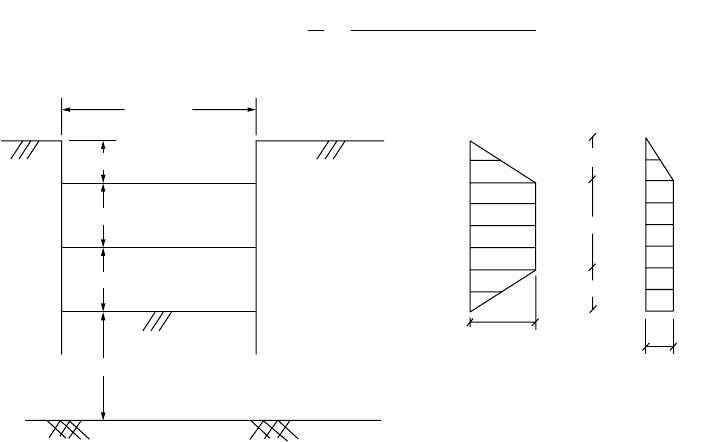
Retaining Structures 22-11
internal strut, and its capacity depends greatly on the bond developed between the soil and grouted
anchorage. Tieback systems consequently require good soil conditions and the absence of obstructions
in the surrounding ground. Typically, the tieback system is checked against anchor pullout by proof
testing each anchor to 100 to 150% of the design load, and the required lengths of the anchors are
determined by ensuring their anchorage zones are located behind potential failure surfaces. Because
preloading anchors to roughly 80% of their design load maintains a nearly at-rest stress state in the
ground, lateral earth pressures are often assumed to be near at-rest pressures. Numerous other support
systems have been developed and, depending on the availability of specialized contractors, these systems
may be advantageous. For example, in good soils, soil nailing with a reinforced shotcrete wall has proved
to be effective and cost-efficient.
Example 22.3 — Braced Excavation
For the braced excavation shown in Fig. 22.11(a), develop estimates of the strut loads, maximum wale
moment, maximum wall moment, and maximum excavation-induced ground movements.
Solution. (a) Apparent pressures:
Since N is only slightly larger than 4, both Terzaghi and Peck [1967] clay apparent pressure diagrams
should be calculated. The one with the largest resultant should be used (i.e., the left one in which R =
283 kN/m).
(b) Strut loads:
FIGURE 22.11 Example 22.3.
Stability number N
g
H
c
-------=
2 Mg m§
3
()9.81 m s§
2
()8 m()
35 kPa
---------------------------------------------------------------------------- 4.5==
S11.15
1
2
--
47.1 kPa()2 m()47.1 kPa()1.5 m()+[]6 m = 810 kN =
S247.1 kPa()2.5 m()
1
2
--
47.1 kPa + 35.4 kPa()0.5 m()+[]6 m = 830 kN =
B = 10m
S1
2m
3m
3m
5m
S2
L = 100m
2m
4m
2m
R = 3/4 (47kPa)(8m)
= 283 kN/m
R = 7/8 (17kPa)(8m)
= 119 kN/m
CLAY
ρ
t
= 2 Mg/m
3
c = 35 kPa
q
s
= 10 kPa
6m strut spacing
0.3(19.6kN/m
3
)(8m) = 47 kPa
(19.6kN/m
3
)(8m) − 4(35kPa) = 17 kPa
γ = ρ
t
g = (2 Mg/m
3
)(9.81 m/s
2
)
= 19.6 kN/m
3
Stability number
N
=
(2 Mg/m
3
)(9.81 m/s
2
)(8 m)
g
H
c
35 kPa
= 4.5
=
(a) (b)
© 2003 by CRC Press LLC

22-12 The Civil Engineering Handbook, Second Edition
(c) Maximum wale moment:
(d) Maximum wall moment:
(e) Estimate ground movements:
Using Fig. 22.10, for a typical sheetpile wall with FS
BH
ª 1.6, D
h,m
ª 1.0%H, or D
h,m
ª 0.01(8 m) = 0.08
m = 8 cm.
In urban areas, maximum wall movements should normally be kept less than 5 cm. A heavy sheetpile
wall (e.g., PZ 40) or a relatively stiff concrete slurry wall could be used to increase the system stiffness
and reduce ground movements.
22.6 Summary
The analytical techniques presented in this section for retaining structures are based on simple models
that have been empirically calibrated. Much depends on the method of construction of these systems
and the quality of the workmanship involved. Hence, sound engineering judgment should be exercised
and local experience in similar ground conditions is invaluable. Much can be gained by implementing
an integrated approach that uniquely considers the project’s subsurface conditions, site constraints, and
excavation procedures [see Bray et al., 1993]. Finite element programs [e.g., SOILSTRUCT, Filz et al.,
1990], which capture the unique soil-structure response of each excavation system, can provide salient
insights and assist in identifying critical aspects of a particular project. The monitoring of field instru-
mentation (e.g., inclinometers) during excavation allows the engineer to verify the reasonableness of the
analysis and to employ the observational method to optimize the design during construction.
Defining Terms
Apparent lateral earth pressure — Lateral earth pressure acting on tributary area of flexible retaining
wall that is necessary to develop measured strut loads.
Base heave — Upward movement of base of excavation and associated inward movement of retaining
wall due to bearing capacity-type instability of base soil.
Lateral earth pressure coefficient — Horizontal effective stress divided by vertical effective stress at a
point.
M
max
2
3
--
AP
˯
ʈ
l
max
2
10
-----------------------------
2
3
--
830 kN
6 m
-----------------
◊
˯
ʈ
6 m()
2
10
----------------------------------------------- 330 kN-m== =
M
max
2
3
--
AP
˯
ʈ
l
max
2
8
-----------------------------
2
3
--
47.1 kPa◊
˯
ʈ
3 m()
2
8
-------------------------------------------------- 35 kN-m m§== =
N
c
51 0.2BL§+()51 0.2()10 m()100§ m+()5.1== =
D¢ 5 m 0.7 10 m()£ 7 m==
FS
BH
cN
C
g
HqcHD¢§–+
---------------------------------------=
35 kPa()5.1()
2 Mg m
3
§()9.81m s§
2
()8 m()10 kPa 35 kPa()8 m()5 m§–+
------------------------------------------------------------------------------------------------------------------------------------------------------= 1.6=
© 2003 by CRC Press LLC
Retaining Structures 22-13
Lateral earth pressure coefficient at rest — Lateral earth pressure coefficient when the lateral strain
in the soil is zero. Realized for case of 1-D vertical compression (e.g., level ground).
Maximum passive earth pressure coefficient — Maximum value of the lateral earth pressure coeffi-
cient. Realized when soil compresses laterally and its full strength is mobilized.
Minimum active earth pressure coefficient — Minimum value of the lateral earth pressure coeffi-
cient. Realized when soil expands laterally and its full strength is mobilized.
Overconsolidation ratio — Maximum vertical effective stress in the past divided by the current vertical
effective stress.
References
Barker, R. M., Duncan, J. M., Rojiani, V. B., Ooi, P. S. K., Tan, C. K., and Kim, S. G. 1991. Manuals for
the Design of Bridge Foundations. National Cooperative Highway Research Program Report 343,
TRB, Washington, D.C., December.
Bray, J. D., Deschamps, R. J., Parkison, R. S., and Augello, A. J. 1993. Braced excavation at the NIPSCO
Bailly Station power plant. In Proc. 3rd Int. Conf. Case Histories Geotech. Eng., pp. 765–774. St.
Louis, MO.
Clough, G. W., and Duncan, J. M. 1991. Earth pressures. In Foundation Engineering Handbook, ed. H-Y.
Fang, pp. 224–235. Van Nostrand Reinhold, New York.
Clough, G. W., and O’Rourke, T. D. 1990. Construction induced movements of in situ walls. In Proc.
ASCE Design Performance Earth Retaining Struct., eds. P. C. Lambe and L. A. Hansen, pp. 439–470.
Ithaca, NY, June 18–21.
Clough, G. W., Smith, E. M., and Sweeny, B. P. 1989. Movement control of excavation support systems
by iterative design. Proc. ASCE Found. Eng.: Curr. Principles Pract., 2:869–884.
Coulomb, C. A. 1776. Essai sur une application des règles des maximis et minimis à quelques problèmes
be statique relatifs à l’architecture. Mèm. Acad. Roy. des Sciences, Paris. 3:38.
Department of the Navy. 1982. Foundations and Earth Structures: Design Manual 7.2. NAVFAC DM-7.2,
May.
Duncan, J. M., and Seed, R. B. 1986. Compaction-induced earth pressure under K
0
-conditions. J. Geotech.
Eng., ASCE. 112(1):1–22.
Filz, G., Clough, G. W., and Duncan, J. M. 1990. Draft user’s manual for program SOILSTRUCT
(isotropic) plane strain with beam element. Geotech. Eng. Rep. Virginia Tech, Blacksburg, March.
Jaky, J. 1944. The coefficient of earth pressure at-rest. J. Soc. Hungarian Architects Engineers. Budapest,
Hungary, pp. 355–358.
Juran, I., and Elias, V. 1991. Ground anchors and soil nails in retaining structures. In Foundation
Engineering Handbook, ed. H-Y. Fang, pp. 868–905. Van Nostrand Reinhold, New York.
Kulhawy, F. H., and Mayne, P. W. 1990. Manual on Estimating Soil Properties for Foundation Design.
EL-6800, Research Project 1493-6 Final Report. Electric Power Research Institute, Palo Alto, CA.
Lambe, P. C., and Hansen, L. A., eds. 1990. Design and Performance of Earth Retaining Structures. ASCE
Geotechnical Special Publication No.25, New York.
Mayne, P. W., and Kulhawy, F. H. 1982. K
0
-OCR relationships in soil. J. Geotech. Eng., ASCE.
108(GT6):851–872.
Mitchell, J. K., and Villet, W. C. B. 1987. Reinforcement of Earth Slopes and Embankments. National
Cooperative Highway Research Program Report 290, TRB, Washington, D.C., June.
Peck, R. B., Hanson, W. E., and Thornburn, T. H. 1974. Foundation Engineering. John Wiley & Sons,
New York.
Rankine, W. J. M. 1857. On the Stability of Loose Earth. Philos. Trans. R. Soc., London, 147(1):9–27.
Rowe, P. W. 1957. Limit design of flexible walls. Proc. Midland Soil Mech. Found. Eng. Soc. 1:29–40.
Schmidt, B. 1966. Discussion of “Earth pressures at-rest related to stress history,” Can. Geotech. J.
3(4):239–242.
© 2003 by CRC Press LLC
